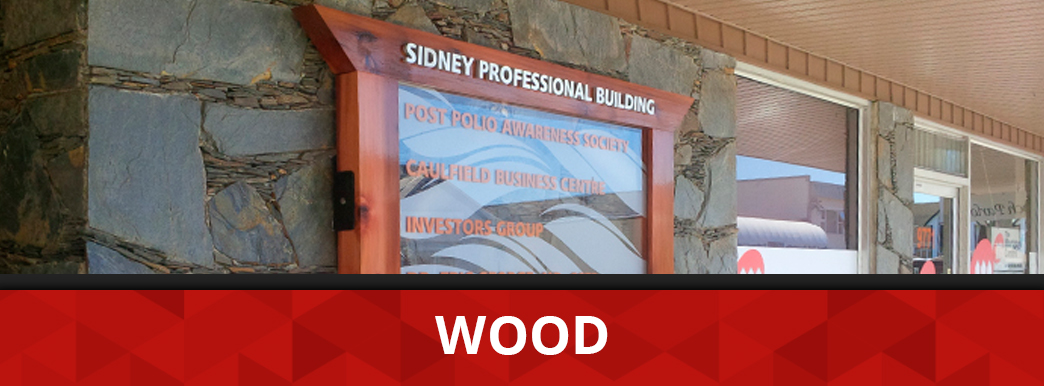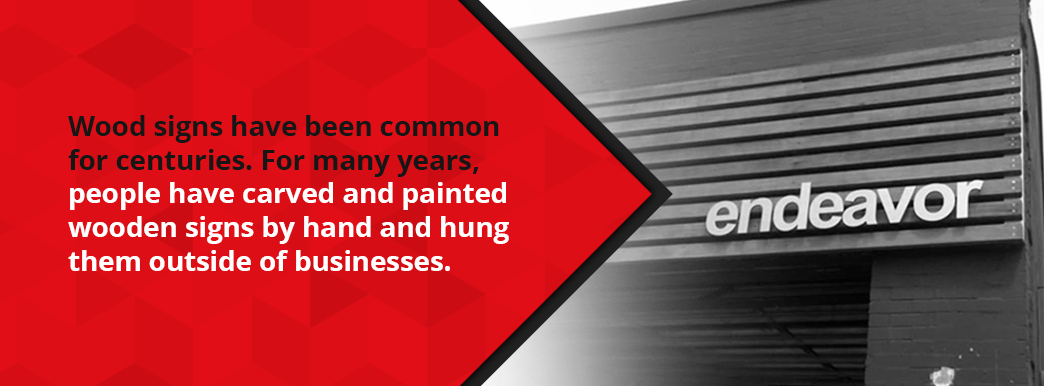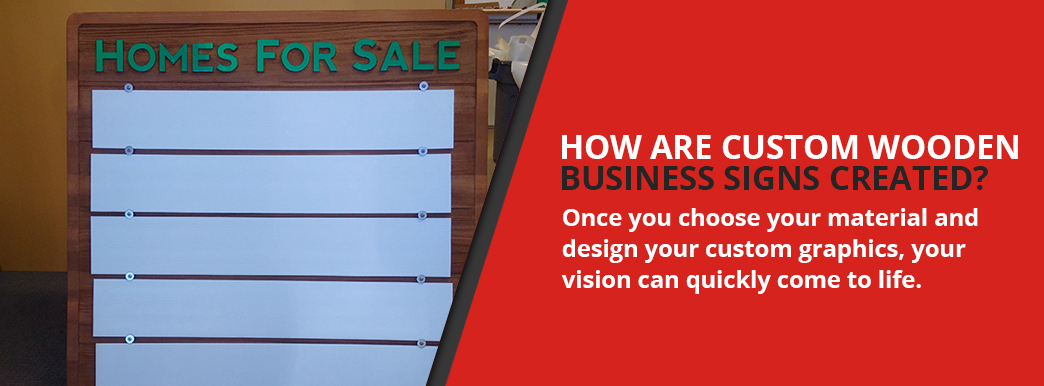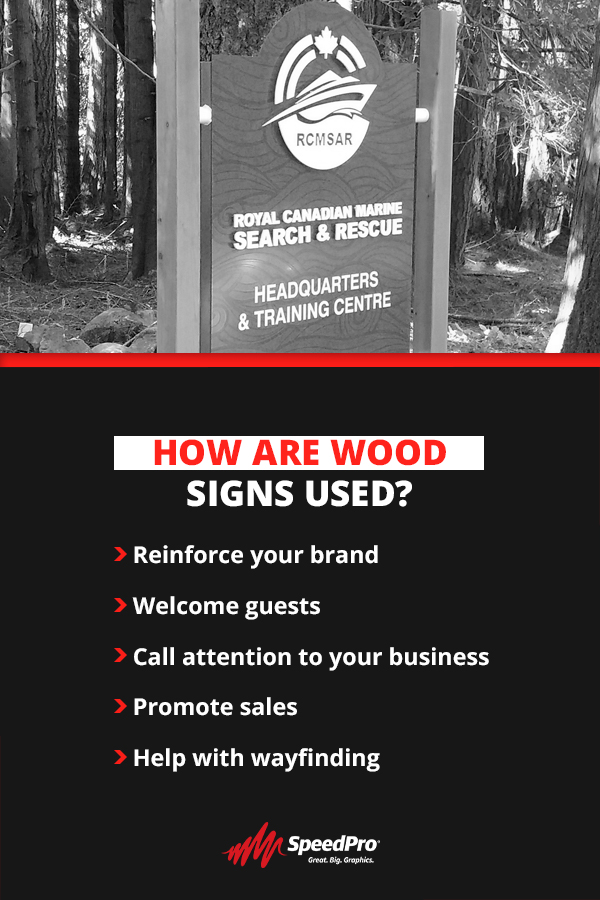Wood is a timeless signage material that is just as relevant today as it was centuries ago. Wood can be an excellent material choice for many types of signage, including outdoor signs. Whether you’re looking for a lightweight, portable a-frame sign to pop up on the sidewalk or a large custom wood sign to be a permanent fixture of your business, SpeedPro can help bring your vision to life with quality wood materials.
WHAT ARE CUSTOM WOOD SIGNS?
Wood signs have been common for centuries. For many years, people have carved and painted wooden signs by hand and hung them outside of businesses. Today, businesses still use custom signage, and while there is a greater variety of materials to choose from today, wood is still a great option to consider. Wood is a versatile material that can help you create anything from a simple a-frame sign to more elaborate dimensional signage.
Wood represents a whole category of materials. Hand-carved wooden signs will be made out of solid wood such as cedar or redwood. Some modern router-cut wooden signs may also be made out of solid hardwoods. However, the more popular wood material for wood signage today is medium density overlay (MDO).
MDO is a type of exterior-grade plywood that is covered in a fiber surface layer that bonds to the wood through pressure and heat. This overlay contains resin and fortifies the wood to resist the elements as well as general wear and tear. When you want a durable outdoor wood sign for your business, MDO is an excellent option to consider.
Some materials, such as wood grain vinyl, are made to look like wood but are fundamentally different materials. Other materials, such as Gatorfoam, include wood as a fiber veneer, but the core of this material is foam. On this page, we are focusing on fully wooden materials, including MDO and solid wood.
WHAT OPTIONS ARE AVAILABLE FOR WOOD SIGNS?
When it comes to wood, there are nearly limitless options to choose from. If you want to go with solid wood, you’ll find that different species of wood offer their own unique advantages and disadvantages as well as widely varying price points. Different species of wood also look different from each other, so if you’re interested in a certain grain or color, that can help you choose your material. One advantage of solid wood is that you can stain it, which allows you to customize the look.
Solid wood may be the best choice if you want to create a sign that appears rustic or has an old-world feel. However, MDO is typically preferable in all other cases since it’s more affordable and weather-resistant. You can treat lumber for outdoor use, but MDO always comes with a weather-resistant surface.
Beyond the material itself, there are several ways you can customize your wood sign:
- Thickness: MDO panels tend to be pretty thin, but they come in different thicknesses. The most common thickness is 1/2 inch. Another thickness you may be able to request is 3/4 inch. If you want an especially thick sign, you’ll want to go with hardwood.
- Size: You can also customize your sign by selecting the appropriate size. MDO panels most commonly come in 4-by-8-foot panels, but you may be able to request a larger panel to accommodate a larger sign.
- Finish: When you order MDO, you can select a primed finish, which is either matte or a glossy, painted finish. Either way, the color will most likely be white. For solid woods, you can choose from natural or stained finishes.
- Print method: There are two options for printing on MDO panels. Your MDO board can either be overlayed with vinyl or can be printed directly with a UV printer. If you want a more rustic look, consider a natural-colored wooden dimensional sign.
- Shape: A common shape for wood signs is the a-frame, which is freestanding and can easily be set up, taken down, and moved around. You can also create dimensional wooden signs in custom shapes.
- Custom graphics: Finally, as with any material, you can customize your sign with personalized graphics. Your graphic can be full color and can consist of custom artwork, photographs, text or any combination of those elements.
HOW ARE CUSTOM WOODEN BUSINESS SIGNS CREATED?
Once you choose your material and design your custom graphics, your vision can quickly come to life. That’s because, unlike hand-carved wooden signs, custom wood signs today are cut using machines. Specifically, they’re typically cut with a computer numerical control (CNC) router.
This machine allows the sign-maker to provide a template through a computer-assisted design (CAD) program. The router will determine how to cut the wood to create the finished product the sign-maker requested. It’s amazing what these machines are capable of. They can quickly create intricate designs that would be time-consuming and difficult to create manually.
In some cases, you may want to create letters or custom shapes and leave them plain. If so, the process would be finished once the cutting is complete. However, in most cases, you’ll want to add your custom colors and graphics to your wood sign.
If the panel is flat enough, then your local SpeedPro studio will be able to direct print onto the material with a UV printer. This type of printing works the same as printing onto other common materials like paper. The other option is to print your graphics onto vinyl and then transfer this vinyl to the surface of your sign. Once the wood board is cut and printed, you’ll have a custom sign you can display at your home or business.
WHAT ARE THE BENEFITS OF WOOD AS A SIGN MATERIAL?
Why should you consider using wood for your signage project? Wood, especially MDO, is a common sign material for good reason. Let’s look at some of the advantages that wood offers. Wood is:
- Versatile: Wood is an extremely versatile material that can work for a variety of signage projects, from a rustic cabin sign to a simple sidewalk sign to an elegant dimensional sign. Since there are so many types of wood to choose from, you can find the right kind that offers the advantage you’re looking for, whether it be portability, affordability, or a certain look. Wood also works both indoors and outdoors, which adds to its versatility as a sign material.
- Durable: Wood signs are also very durable, even in outdoor conditions. Some may find this surprising since wood is sensitive to temperature changes, water, and other environmental factors. It is true that untreated wood will not fare well outside over time. However, if you use sealed wood or MDO, then you can expect a wood sign to hold up for many years. For solid wood, you may have to treat your sign periodically to maintain its layer of protection.
- Portable: Some woods can be heavy, but many wood materials, including MDO, are quite lightweight. In fact, MDO is exceptionally light, even compared to particleboard and other types of plywood. Since wood signs can be lightweight, they’re easy to install and move to new locations. A-frame signs are especially portable since you can easily fold them up to pack them to new locations. To set them up, you simply unfold the sign and set it on any surface.
- Multi-dimensional: Because wood is a thicker material, it’s a perfect choice for dimensional signage. Wood also works well for dimensional signage because it can be cut along three axes to create the exact shape and texture you want. When you want your sign to pop from its surroundings, whether it’s a company name, a logo, or another graphic image, adding a third dimension is a great way to do that. Dimensional signage can be more memorable than flat signs because they are attention-getting.
- Timeless: Finally, wood is a timeless material. This strength especially applies to solid wood, which has been used as a sign material for many years. Wood signs blend seamlessly in a natural environment, making it an excellent choice for parks, campgrounds, zoos, and more. Wood signs are also the perfect choice for shops, pubs, and restaurants that hearken back to an earlier time. Even if you’re not going for a rustic look, wood signs have an air of quality and elegance that can make them an excellent choice for your business.
ARE THERE ANY DOWNSIDES TO WOOD?
As with any material, wood has some potential downsides, as well. The main drawback for some customers is that wooden signs can be more expensive than other sign materials. This largely depends on the type of wood you choose. Some kinds of wood are expensive, but this is not true for all lumber. MDO is exceptionally affordable if cost is a concern for you or your business.
Another potential downside to wood is that wood can be heavy. This feature can give wood a high-quality feel, but it can also make it difficult to hang or move. As with the downside of expense, the downside of weight also applies to solid wood more so than MDO, which is a relatively affordable material. Different species of wood vary in weight, so some options are lightweight while others may be heavy.
HOW DOES WOOD COMPARE TO OTHER DIMENSIONAL SIGNAGE MATERIALS?
Let’s take a moment to look at some other materials you could use for dimensional signage and see how wood compares:
- Metal: Metal signs tend to have a more industrial look compared to the warmth of wood. This is fitting for some businesses, depending on the look they’re going for. Metals can be coated to protect them from the elements, meaning the metal is another option to consider for outdoor signage.
- Acrylic: Acrylic is also an indoor/outdoor material that is made to last. Acrylic is fairly lightweight and durable, so you don’t have to worry about it cracking or fading over time. Acrylic signs can look impressive and sleek, while wood signs tend to have a more traditional feel.
- Foamcore: Foamcore consists of foam covered on a paper surface. Foamcore is inexpensive and is a good option for temporary indoor signs, but it’s not made to last like wood is.
- Ultraboard/gatorboard: Ultraboard and gatorboard are similar to foam core in that they have a foam interior, but that interior is covered by a more durable substrate. In the case of the gatorboard, this outside layer is a veneer of melamine and wood fiber. For ultra board, it’s polystyrene plastic. Though these are durable materials, they are not suitable for outdoor use.
HOW ARE WOOD SIGNS USED?
You can use wooden signs for a variety of purposes, including for decorative features at home. Here are some ideas for how you can use wood signs at your business:
- Reinforce your brand: Your corporate branding is an essential feature of your business, and you can use signage to reinforce brand awareness. Imagine a high-quality custom wood logo sign on the wall behind your reception desk or a sleek MDO sign with your branded graphics at your trade show booth.
- Welcome guests: A wooden sign can have a warm, homey feel that is perfect for welcoming guests. This is especially important for businesses in the hospitality sector, such as hotels and restaurants. You could always purchase a generic welcome sign, but a personalized welcome sign that’s consistent with your branding will appear more professional.
- Call attention to your business: An exterior wood sign can be a permanent feature of the face of your business which will let the public know where your business is located. Whereas billboards and other types of advertising signage will cost you for the space they inhabit, your business’s location is yours, so you should make the most of this advertising opportunity.
- Promote sales: You can also use custom outdoor wood signs to promote sales your business is running. Whether it’s a sidewalk sale or special discounted pricing inside, wooden a-frame signs are a great option to get the attention of passersby and entice them to stop by and see how they could save money on a great product or service.
- Help with wayfinding: Directional signage is crucial for helping customers and employees navigate your building. If wood fits in well with your business’s aesthetic, you can use wooden signs to label conference rooms, offices, or departments or signal the direction to features like bathrooms or exits.




